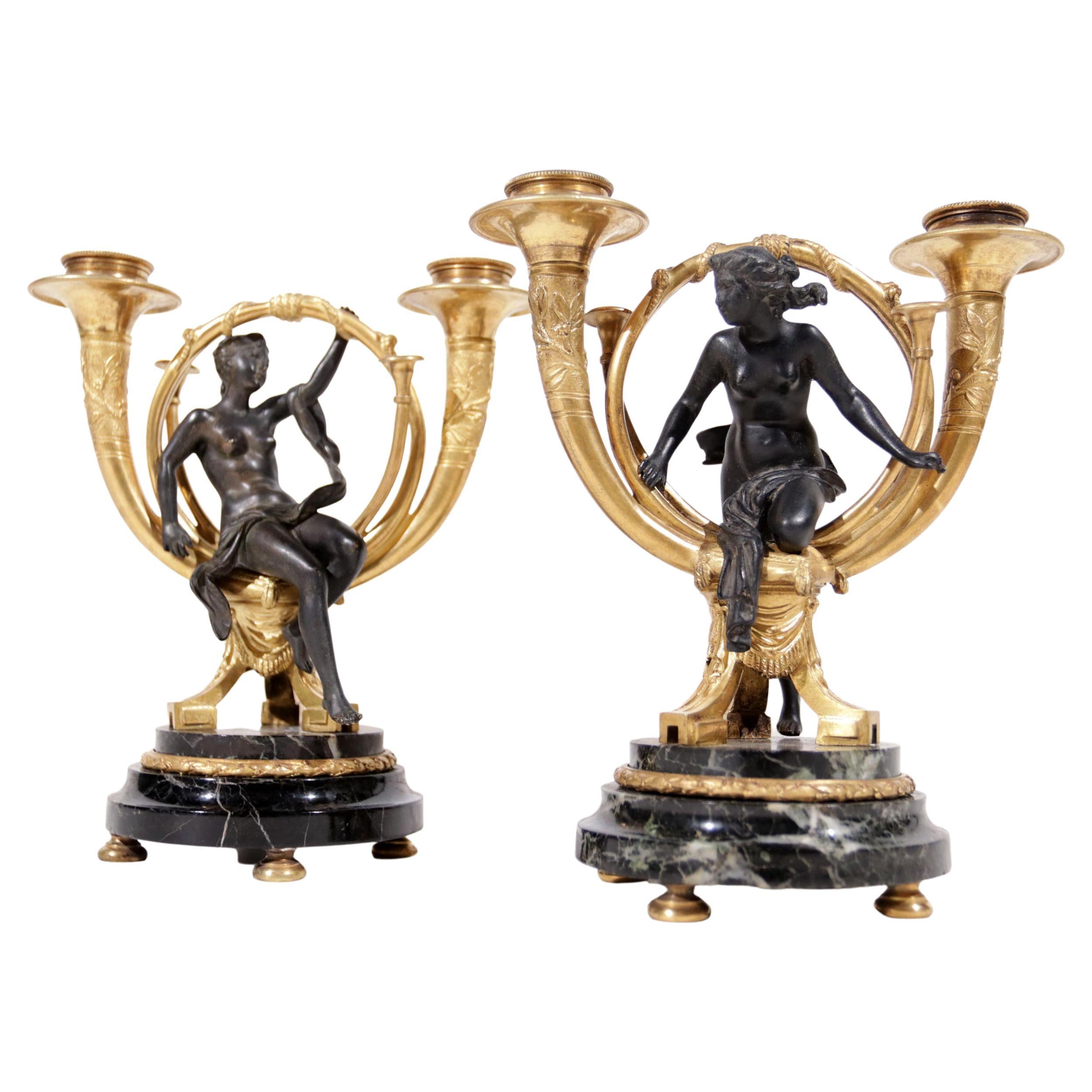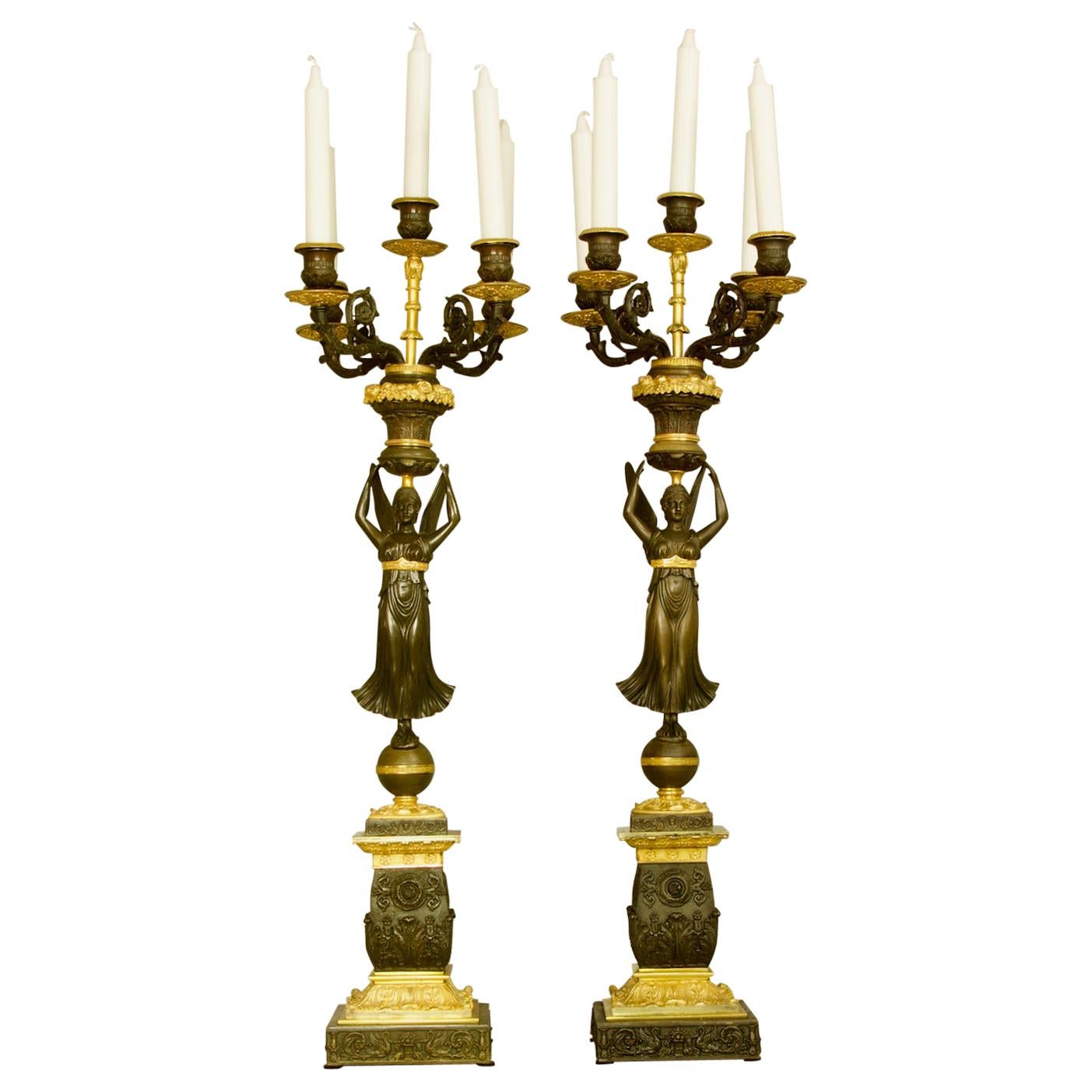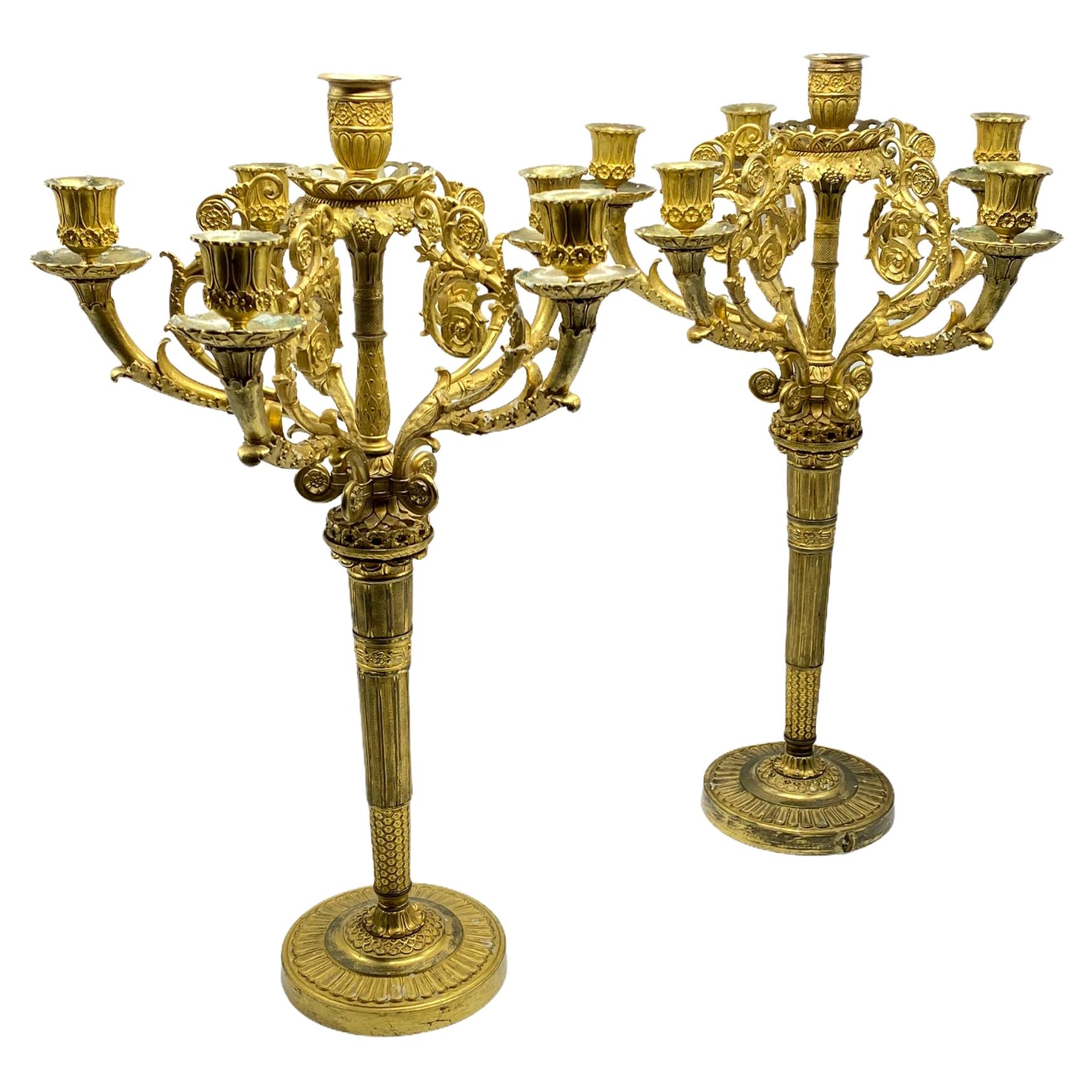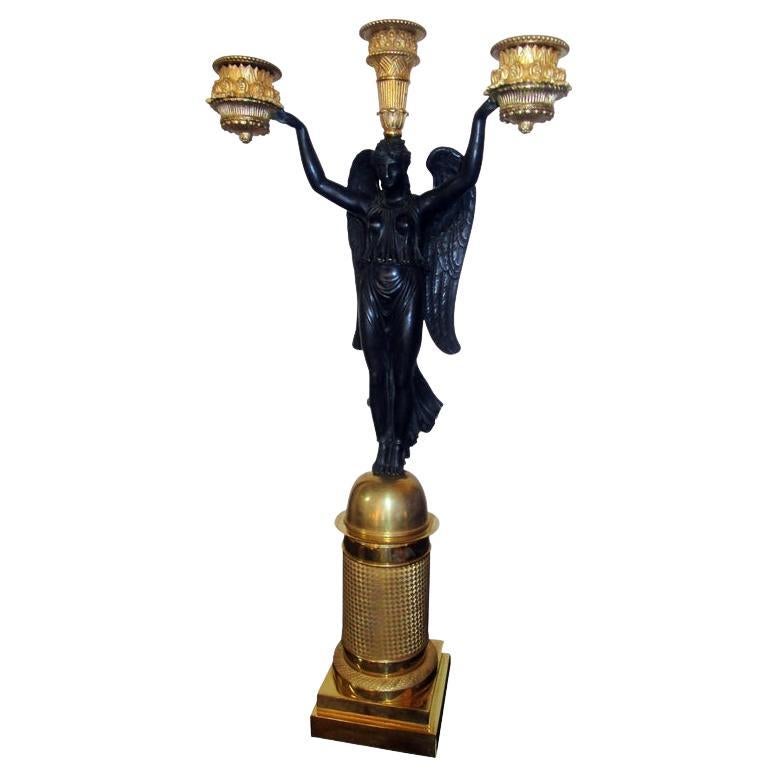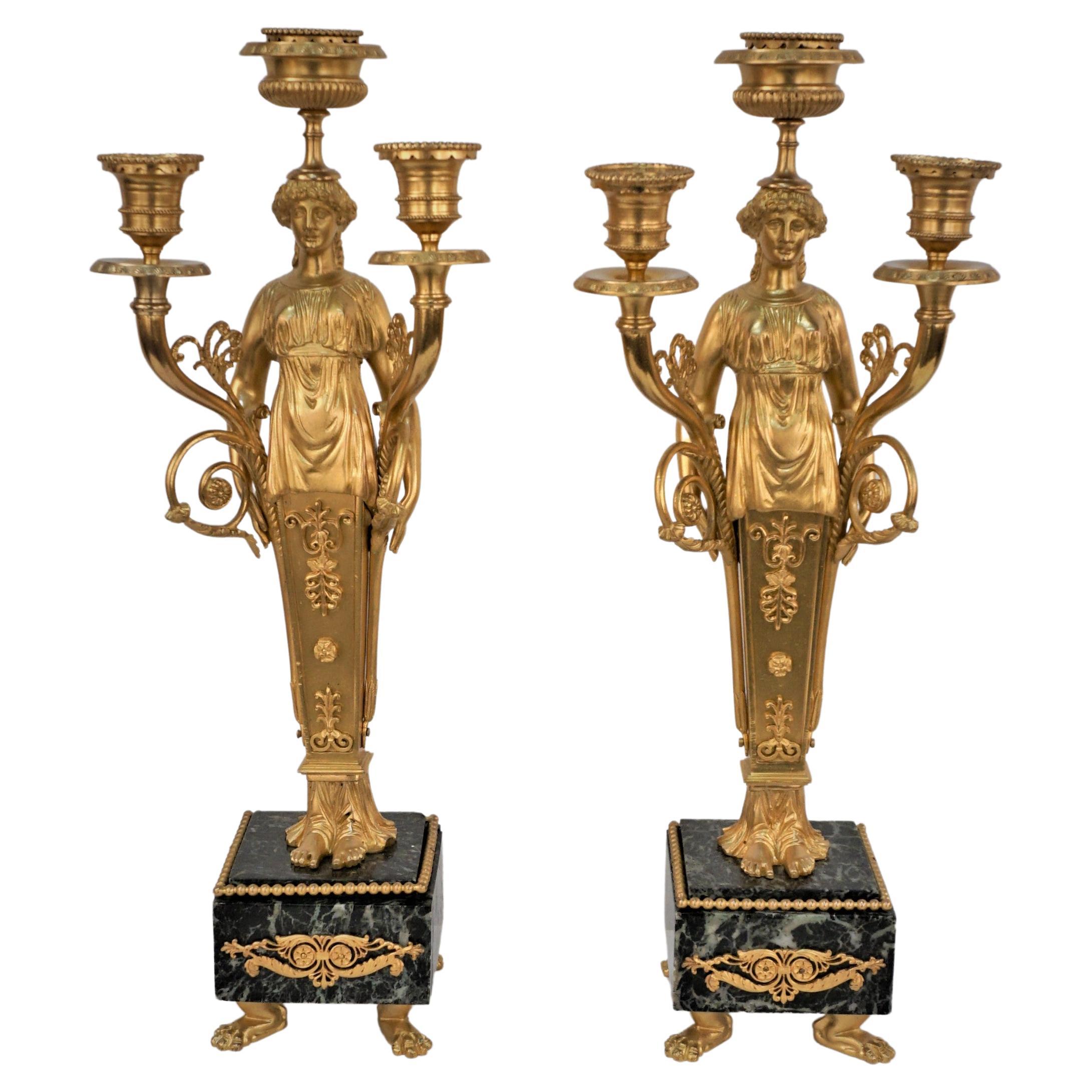Items Similar to Exceptional Pair of French Late Empire Gilt-bronze Candelabra Attributed to Pier
Want more images or videos?
Request additional images or videos from the seller
1 of 15
Exceptional Pair of French Late Empire Gilt-bronze Candelabra Attributed to Pier
About the Item
A pair of exceptionally elegant and important late Empire five-light figural candelabra ‘A la Victoire’ in gilt-bronze, attributed to Pierre-Philippe Thomire, after a design by Charles Percier. Imposing size at 81cm in height.
French Paris c.1820
Superbly cast, in the Neo-Classical style, the five scrolling foliate candle branches enclosing central sconces issuing from a circular wreath supported by the winged figure of Victory (Nike), wearing diaphanous robes gathered by a sash above a long underskirt splaying out from above her ankles, with beautifully feathered wings flowing behind her as she looks straight ahead. Each figure standing on one foot, the other bent, resting on a plain sphere over a reeded palmette-cast baluster pedestal raised on square plinth. Wonderful colour and patina, pierced for electricity, old inventory label to the underside.
We are delighted to have been able to acquire these important candelabra as rarely does one get the opportunity to purchase items by P P Thomire, who was the leading Parisian gilt metal manufacturer and gilder of the early 19th century. As noted below candelabra of this caliber are often found in museums and important private & Royal collections.
It is certain that the candelabra came from a private Swiss collection and had been in the family for sometime. Their earlier provenance is partially revealed by an old depository label attached to the base of one of the pieces. The label is for the firm of Case and Sons of Salisbury, a very old and important removal firm established in 1884.
The label also gives the name of Case's client at the time-a "Mr Cobbold". Our research in to the various Cobbold families in the Wiltshire area has revealed one name of particular interest, Mr Ralph Hamilton Cobbold. Born in 1906 in Compton House near Calne in Wiltshire, Cobbold was a very keen amateur cricketer and a director of the world famous London wine merchants Justerini and Brooks. He was married three times, his first marriage being to Norah Veronica Christie-Miller of the even more impressive Clarendon Park on the edge of Salisbury. The two were married in 1933 and Cobbold came to live in his wife's home. However he divorced and remarried in 1945 and eventually moved away to Suffolk. Given the sorts of funds that would have been necessary to have purchased these remarkable pieces, they can only have belonged to a very wealthy and important family and R. H. Cobbold certainly fits that mould perfectly. Although we have not been able to find documentary evidence so this can only be supposition, it is quite likely that the candelabra were taken by Cobbold to his new home following his first divorce and then sold. If this is the case then the pieces could either have been purchased on the art market or inherited through either the Cobbold or Christie-Miller family lines.
Literature
The present candelabra were certainly made after, or at least inspired by, designs by the architects Charles Percier (1764–1838) and Pierre-François-Léonard Fontaine (1762–1853) who were the two most influential figures in the field of Empire decoration and furnishing. Official architects to the court of Napoleon, their main responsibility was the renovation of the various royal residences. Their Recueil des décorations intérieures (1812) was an essential handbook of the Empire style. The personification of Victory as a winged figure became an integral element within Empire design as a symbol of military triumph through the intervention of Percier and Fontaine. The design for the present pair of candelabra is believed to have derived from a design by Charles Percier’s workshop in his drawings for Empress Josephine’s boudoir at Saint Cloud (*at the Metropolitan Museum in New York). This depicts the winged figure of Victory balanced on one foot supporting candelabra. The design was successfully exploited by Thomire (1751-1843) as well as his contemporary Claude Galle (1759-1815).
Pierre-Philippe Thomire was almost unrivalled as a bronzeur in this period. Thomire, who was born in Paris, followed his father's profession as a fondeur-ciseleur. His career was advanced when he studied under the great fondeur-doreur, Pierre Gouthière, from whom he acquired the most refined skills in chasing and gilding, in particular matt gilding 'dorure au matt', to produce a subtle grainy satin-like finish. By the late eighteenth century Thomire had achieved considerable renown, having enjoyed the patronage of Louis XVI. His name occurs often in the accounts of the Royal Furniture Repository between 1784-1789, in the ledgers of Louis XVI and in those of the manufactory of Sevres. After the French Revolution he returned to making decorative bronzes and thereafter enjoyed the patronage of Napoleon and subsequently the restored Bourbon monarchy, as well as foreign royalty and aristocracy.
Appointed a maître-fondeur in 1772, he set up his own business in 1776 following a collaboration with Jean-Louis Prieur in the decoration of Louis XVI's coronation coach. Other royal commissions followed, for instance he supplied gilt bronze chenets with flaming urns and sphinxes for the Louvre in 1786. Having assisted in the making of the mounts for the Sèvres Grands Vases (Musée du Louvre, Paris and Pitti Palace Florence), in 1783 he succeeded Jean-Claude-Thomas Duplessis as chief supplier of mounts for Sèvres, which was an important post and assured Thomire's future. From 1804 he ran the leading bronze manufactory in Paris. In 1806 Thomire became the first bronzier to be awarded a gold medal at the Exposition des Produits de l'Industrie. He won another gold in 1809, in which year he was also appointed ciseleur de l'Empereur. 1823 saw Thomire winning a gold medal for sculpture in Paris as well as his retirement from the firm though he continued to produce sculptures and regularly exhibited at the Paris Salon until 1834. His business was continued by his two sons-in-law up until 1852 although Thomire's legacy has continued for much longer.
His work has often been confused with that of his contemporary Claude Galle with whom he sometimes collaborated. Today Thomire's work can be found in the world's finest collections including numerous former royal and imperial French châteaux, the Musée du Louvre in Paris, the Hermitage Museum in Saint Petersburg, the Metropolitan Museum, New York, the J. Paul Getty Museum, California, as well as the Victoria & Albert Museum, London and the British Royal Collections.
Width: 13 inches - 33cm
Height: 33 1/2 inches - 85cm
Depth: 13 inches - 33cm
- Attributed to:Pierre-Philippe Thomire (Maker)
- Dimensions:Height: 33.47 in (85 cm)Width: 13 in (33 cm)Depth: 13 in (33 cm)
- Sold As:Set of 2
- Style:Empire (Of the Period)
- Materials and Techniques:
- Place of Origin:
- Period:
- Date of Manufacture:Circa 1820
- Condition:Wear consistent with age and use.
- Seller Location:Benington, GB
- Reference Number:
About the Seller
5.0
Gold Seller
These expertly vetted sellers are highly rated and consistently exceed customer expectations.
Established in 1969
1stDibs seller since 2015
112 sales on 1stDibs
Typical response time: <1 hour
Associations
LAPADA - The Association of Arts & Antiques DealersThe British Antique Dealers' Association
- ShippingRetrieving quote...Ships From: Benington, United Kingdom
- Return PolicyA return for this item may be initiated within 3 days of delivery.
More From This SellerView All
- Large French Empire Period Gilt Bronze Figural Mantel Clock of Exceptional QualiLocated in Benington, HertsA large and impressive French Empire period gilt bronze mantel clock of exceptional quality and colour. French (possibly retailed in Italy) - Circa 1820. The finely chased and original gilt bronze case depicting Orpheus playing his lyre with an eight-day bell striking movement, outside countwheel, backplate initialled and numbered 'A C D 1516’. The dial with Roman numerals and inscribed Riccardo Pacinoti of Lavourne. It is a French movement (silk suspension) striking the hour and half hour. The case in the form of an oblong pillar cast with anthemium and cornucopia beneath a draped urn and a laurel wreath, flanked by the figure of Orpheus playing his lyre, the stepped plinth cast with wonderfully detailed underworld scenes, on leaf scroll feet. In excellent condition the clock case has been cleaned with the movement completely overhauled and serviced to the highest standard by a specialist restorer. In general 19th century French bronze clocks...Category
Antique 1820s French Empire Mantel Clocks
MaterialsBronze
- Pair of Early 19th Century Gilt Bronze and Lustres Three Branch CandelabraLocated in Benington, HertsA very attractive pair of early 19th century three branch gilt bronze candelabra with cut-glass lustres. Probably English Circa 1820. Of rare form and in wonderful orig...Category
Antique 19th Century British Regency More Lighting
MaterialsBronze
- An Important Pair of French Wall Appliques/Lights Attributed to André Leon ArbusBy André ArbusLocated in Benington, HertsA rare and important pair of French Mid 20th century wall appliqués / wall lights from the French Art Deco period attributed to André Leon Arbus and Gilbert Poillerat. Two pairs avai...Category
Mid-20th Century French Mid-Century Modern Wall Lights and Sconces
MaterialsGlass
- Regency Amboyna and Brass Inlaid Gilt Bronze Mounted Pier TableLocated in Benington, HertsAn extremely elegant, rare Regency amboyna and brass inlaid gilt bronze mounted pier table. Provenance Part of Sir William Whitfield Collection. English Regency period, Circa 1815. The raised back with open shelf, surmounted by a pierced anthemion three quarter brass gallery above a rectangular mirror plate, flanked by gilt bronze pierced foliate scrolled supports, over a finely coloured amboyna and banded top above cut brass inlaid frieze drawer decorated with anthemion and flower head motif. The dual tapering scroll supports with palmette lappet surmounts and cut brass inlay terminate on gilt bronze claw feet, flanking a later large mirror plate to the rear, raised on a inverted breakfront plinth base edged with gilt bonze beading. Formerly in the collection of Sir William Whitfield. This elegant Regency pier table is a superb example with its fine quality mounts and distinctive amboyna veneers which are rarely found on furniture of this period. The condition is excellent, having the most wonderful colour and patination to the finest cuts of amboyna that would have been available, during the early 19th century this veneer was thought to be worth more in its weight than gold. This table would have almost certainly been especially commissioned, further research maybe undertaken to find a comparative example and insight to a potential maker. As such pieces in amboyna are far rarer, an example of pier table has yet to be found, but an amboyna sofa table with extremely similar brass inlay and form can be seen in Clifford Musgrave’s book Regency Furniture, published by Faber and Faber in 1961, plate 63. It is from the Royal Collection and the caption includes ‘made about 1816 for Clarement,’ (Claremont) ‘ Esher, Surrey, home of the Princess Charlotte...Category
Antique 19th Century British Regency Vanities
MaterialsBrass, Bronze
- An Exceptional George Iv Period Boulle Games Table Attributed to Thomas ParkerBy Thomas ParkerLocated in Benington, HertsAn Exceptional Boulle and Ormolu Mounted Games Table in the French Louis XVI style attributed to Thomas Parker (active 1805-1830) English Circa 1825 C...Category
Antique 1820s English Louis XVI Game Tables
MaterialsOrmolu
- Fine Pair of Italian Ormolu Wall Lights or Appliques in the French Empire StyleLocated in Benington, HertsFine Pair of Italian Ormolu Wall Lights or Appliques in the French Empire Style, two pairs are available. Italian - Circa 1880 These lovely wall lights are conceived as notched...Category
Antique Late 19th Century Italian Empire Wall Lights and Sconces
MaterialsOrmolu
You May Also Like
- Pair of French Empire Bronze CandelabraBy Pierre-Philippe ThomireLocated in West Palm Beach, FLPair of French Empire bronze candelabra, sleek and sophisticated in design, each one fitted with three lights, fire gilt details, raised on an...Category
Antique Early 19th Century French Empire Candelabras
MaterialsBronze
- Pair of Exquisite French Empire Gilt Bronze Two-Light Candelabra ca 1810By Pierre-Philippe ThomireLocated in Boven Leeuwen, NLThese candlesticks are ornate artifacts from the French Empire period, which dates back to the early 19th century, typically considered as the reign of Napoleon I from 1804 to 1814. ...Category
Antique 1810s French Empire Candelabras
MaterialsGold, Bronze
- Pair of 19th Century Empire Gilt Bronze and Patinated Bronze Victory CandelabrasBy Pierre-Philippe ThomireLocated in Berlin, DEPair of Large 19th Century Empire Ormolu and Patinated Bronze Victory Sculptures Candelabras in the manner of Philippe Thomire (1751-1843) A large a...Category
Antique 1820s French Empire Candelabras
MaterialsBronze
- Pair of Empire Gilt Bronze CandelabrasLocated in New York, NYPair of period Empire French early 19 century gilt bronze candelabras.Category
Antique 19th Century French Empire Candelabras
MaterialsBronze
- Pierre-Philippe Thomire Attributed Single French Empire Gilt Bronze CandelabrumBy Pierre-Philippe ThomireLocated in Savannah, GAA very fine single French Empire style gilt bronze three-light candelabra featuring the allegorical "à la Victoire". The winged figure holds aloft in her out stretched arms two intricately designed candle-wells in the form of baskets, with an additional basket overhead. She stands balanced on an embossed cylinder over a double plinth with a squared base. This piece is for the serious collector passionate about finely handcrafted decorative arts with superior craftsmanship. It is flawlessly cast and highly detailed, take notice of the folds of her dress that seem to fly in the wind. Done in the distinct manner of Pierre Philippe Thomire (French, 1751-1843) after the original design by Charles Percier...Category
Antique 1810s French Empire Candelabras
MaterialsBronze
- Late 19th Century French Empire Gilt Bronze CandelabraLocated in Fairfax, VAPair of late 19th century empire Dore bronze woman column candelabras with marble base.Category
Antique Late 19th Century French Empire Candelabras
MaterialsMarble, Bronze
Recently Viewed
View AllMore Ways To Browse
Pierre Chenet Bronze
Pierre Chenet
Satin Coach
Napoleon Josephine Bronze
Welz Vase
Zigzag Cassina
1950 Ethan Allen
70s Bathroom Sconce
Antique Silver Small 17th Century Teapots
Aurene Glass Chandelier
Austrian Bronze Cold Painted Rooster
Avem Birds
Bamboo Towel Ring
Bertil Villein
Billiards Watch
Bruno Gambone Bull
Charleston Forge Legacy Leather Barstools
Clover Kundalini

